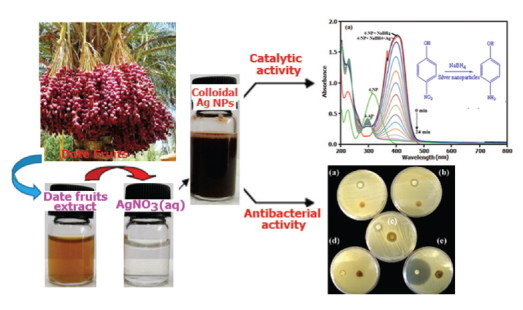Green Biosynthesis of Spherical Silver Nanoparticles by Using Date Palm (Phoenix Dactylifera) Fruit Extract and Study of Their Antibacterial and Catalytic Activities
DOI:
https://doi.org/10.17344/acsi.2016.2956Keywords:
Biosynthesis, Silver nanoparticles, Date palm fruit extract, Antibacterial activity, Nitro reduction, CatalystAbstract
In this work, we have synthesized spherical silver nanoparticles (Ag NPs) by a low-cost, rapid, simple and ecofriendly approach using Date palm fruit extract as a novel natural reducing and stabilizing agent. The product was characterized by UV-visible spectroscopy, X-ray diffraction (XRD), Fourier transform infrared spectroscopy (FTIR), field emission scanning electron microscopy (FESEM), transmission electron microscopy (TEM), atomic force microscopy (AFM), energy-dispersive X-ray (EDX) spectroscopy and Zeta potential measurements. The reaction conditions including time, content of reducing agent and silver nitrate, temperature and pH were investigated. The optimum yield of Ag NPs was obtained when 10 mM of silver nitrate was reacted with Date fruit extract at pH 11 and heated it to 55 oC within 10 minutes. The elemental and crystalline nature of Ag NPs were confirmed from EDX and XRD analysis. SEM and TEM images showed that the Ag NPswere spherical and with sizes in the range of 25-60 nm. On the base of FT-IR analysis, it can be stated that the functional groups present in bio-molecules of Date fruits are responsible for the reduction and stabilization of Ag NPs, respectively. The Ag NPs showed good antibacterial activity against a few human pathogenic bacteria. The catalytic activity of the Ag NPs for rapid and efficient reduction of toxic nitro compounds into less toxic corresponding amines by using NaBH4 was also investigated.

Downloads
Additional Files
Published
Issue
Section
License
Except where otherwise noted, articles in this journal are published under the Creative Commons Attribution 4.0 International License
